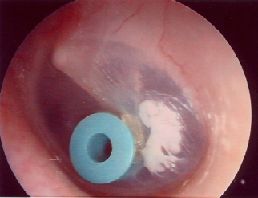Minas N. Artopoulos M.D.
Otorhinolaryngologist, Head & Neck Surgeon
Director of Neck-Thyroid Division at the MITERA Otorhinolaryngology Head & Neck Surgery Department
Many kids get middle ear infections (otitis media, or OM), usually between the ages of 6 months and 2 years.
Some kids are particularly susceptible because of environmental and lifestyle factors (like attendance at a group childcare, secondhand tobacco smoke exposure, and taking a bottle to bed).
Although these infections are relatively easy to treat, a child who has multiple ear infections that do not get better easily or has evidence of hearing loss or speech delay may be a candidate for ear tube surgery.
During this surgery, small tubes are placed in the eardrums to ventilate the area behind the eardrum and keep the pressure equalized to atmospheric pressure in the middle ear.
About Otitis Media
The middle ear is an air-filled cavity located behind the eardrum. When sound enters the ear, it makes the eardrum vibrate, which in turn makes tiny bones in the middle ear vibrate. This transmits sound signals to the inner ear, where nerves relay the signals to the brain.
A small passage leading from the middle ear to the back of the nose — called the eustachian tube — equalizes the air pressure between the middle ear and the outside world. (When your ears pop while yawning or swallowing, the eustachian tubes are adjusting the air pressure in the middle ears.)
Infection
Bacteria or viruses can enter the middle ear through the eustachian tube and cause an infection — this often occurs when a child has had a cold or other respiratory infection. When the middle ear becomes infected, it may fill with fluid or pus, particularly if the infection is bacterial.
Pressure from this buildup pushes on the eardrum and causes pain, and because the eardrum cannot vibrate, the child may experience a temporary decrease in hearing.
With treatment, a bacterial infection can be quickly cleared up. In most kids the fluid will resolve over time and hearing will be restored. Some research suggests that long periods of hearing loss in young children can lead to delays in speech development and learning.
Symptoms and Diagnosis
Symptoms of otitis media include:
pulling or rubbing the ears because of ear pain
fever
fussiness or irritability
fluid leaking from the ear
changes in appetite or sleeping patterns
trouble hearing
Call your doctor if you think your child has an ear infection. He or she will perform a physical examination and look at your child’s eardrums. If the doctor suspects a bacterial infection (often based on the presence of pus behind the eardrum), he or she may elect to wait and see if the immune system will clear the infection without the use of antibiotics.
If symptoms persist (fever and pain) for more than 48 hours, then antibiotics may be prescribed. This is important to know since unnecessary use of antibiotics can lead to resistant bacteria.
In some instances, the doctor will insert a needle through the eardrum to remove a sample of the pus from the middle ear for a laboratory culture. Called a tympanocentesis, this procedure can help the doctor decide which antibiotic to use.
Treatment
Although ear tube surgery is a relatively common procedure, surgery is not the first choice of treatment for otitis media. Antibiotics are often used to treat bacterial ear infections but many ear infections are viral and cannot be treated with antibiotics. These infections need to get better on their own, and only time can help them heal.
But if your child has frequent ear infections that don’t clear up easily or a hearing loss or speech delay, the doctor may suggest surgery to drain fluid from the middle ear and insert a ventilation tube.
Because most kids have had infections in both ears, surgery is often done in both; this is called a bilateral myringotomy, or BMT. A tiny tube, called a pressure equalization (PE) or tympanostomy tube, is inserted into the eardrum to ventilate and equalize pressure in the middle ear. This will help to prevent future infections and the accumulation of fluid, and will help normalize hearing.







